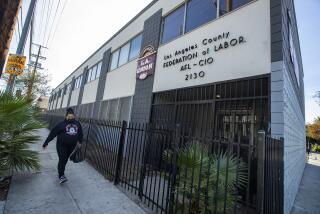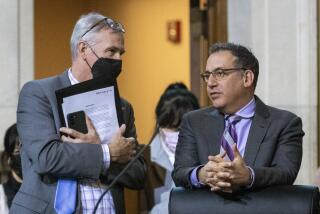Council Packs House at Rare Valley Meeting
- Share via
WOODLAND HILLS — The Los Angeles City Council took its show on the road Tuesday, meeting in the San Fernando Valley for the first time in five years before a crowd that was so large that officials had to rent extra chairs and set up a huge white canopy outside of the main auditorium, where people watched on large color monitors.
Meetings in City Hall typically attract no more than a dozen people. But Tuesday’s meeting at Pierce College drew a crowd of 350, prompting the fire marshal to warn audience members not to block the aisles and exits. Even some of the gadflies who regularly attend the Downtown meetings made the trek to the Valley.
Council member Rudy Svorinich of San Pedro joked that he felt like he traveled through two time zones to get to the meeting.
For many residents, it was their first time seeing their lawmakers live and in action. Some were puzzled by the rules of parliamentary procedure and the rapid-fire way the panel moves from one issue to the next.
“They don’t stick to one topic,” Virgie Litz, a Winnetka resident said of the meeting, the first she had ever watched.
“This one will go off on this tangent and that one will go off on that tangent.”
Since 1983, the council has met outside of City Hall only four times, three of them in the Valley and once in the Harbor area. The last meeting was in 1990, when the council traveled to North Hollywood for a special meeting to discuss the effects of defense cutbacks on the Valley.
To accommodate the meeting, city officials had to rent extra lighting, six television cameras and microwave trucks to televise the event live on cable, at a cost of just over $6,000, according to city officials. It took a crew of city workers an entire day to set up the equipment and chairs.
That did not include the usual cost of running the three-times-a-week meeting, such as salaries for security, clerical staff and the cost of snacks for the council and its staff. For the Valley meeting, city officials shipped out sodas, fruits, muffins and coffee.
The chambers where the council normally meets seat 380 people and is equipped with a built-in sound system, television cameras mounted on the wall and a computerized system that keeps track of votes and monitors the amount of time each speaker is allowed.
For the Valley meeting, the council members voted with a verbal “yes” or “no” and Council President John Ferraro allowed members to speak only after they were recognized by raising their hands.
Although the council balked at a recent proposal to hold four regular meetings outside City Hall each year, members announced that they planned meetings in San Pedro in January and a meeting in the Fairfax District in April.
“This is a really exciting and happy occasion,” said Councilwoman Laura Chick, who represents parts of the West Valley and who proposed the Valley gathering. “You will be seeing us do more of the same in the future.”
The agenda was drafted specifically to focus on issues of local importance. For example, the council voted to use federal funding to provide a $4.6-million rehabilitation loan to the owner of a 135-unit apartment building in Reseda that suffered severe quake damage.
During the discussion, Beatrice Lifshin, a Valley renter, complained that landlords who get earthquake repair loans are allowed to pass the costs to tenants by raising rents.
“I wish you would consider the age and income of people who are getting a $90-a-month increase,” she said.
Several council members said they were surprised to learn that the city’s rent control laws allow landlords to pass the cost of rehabilitation loans on to tenants. They suggested a study on ways to help tenants pay for the increases.
“For our fixed-income tenants or low-income tenants, we are starting to hear about radical increases,” Chick said.
But housing officials told the gathering that when the city offers such a loan, it usually requires landlords to provide low-income housing once the building is rehabilitated.
The council also voted to request a study into the possibility of tearing down the aging buildings in the Van Nuys civic center and replacing them with a modern, efficient facility that could include shops, restaurants and possibly theaters.
Councilman Marvin Braude, who represents parts of Van Nuys, said many smaller cities such as Burbank and Santa Monica have modern administrative centers. With a population of about 1 million people, Braude said, the Valley deserves a new facility.
Los Angeles Police Chief Willie L. Williams, himself a resident of Woodland Hills, was greeted with enthusiastic applause when he took the microphone to report that he was meeting with various council committees to discuss ways to increase police deployment and improve methods of weeding out racism in the force.
Several council members praised the department, defending it against the recent criticism raised during the O.J. Simpson murder trial.
“We have not funded the Police Department the way we should and we are now paying the price,” said Councilman Hal Bernson, who vowed to propose that the city set aside a fixed percentage of each annual budget for police.
As the meeting dragged on, the crowd dramatically thinned.
By the end of the 3 1/2-hour meeting, more than half of the audience had left. When Ferraro called for public comment on issues that did not appear on the agenda, he found that most of the speakers who filled out cards requesting to speak were gone.
More to Read
Sign up for Essential California
The most important California stories and recommendations in your inbox every morning.
You may occasionally receive promotional content from the Los Angeles Times.














